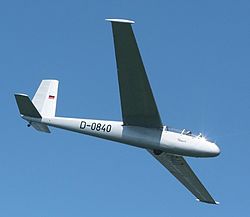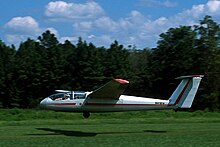Let L-13
| L-13 Blaník | |
|---|---|

|
|
| Type: | Glider |
| Design country: | |
| Manufacturer: | |
| First flight: |
March 1956 |
| Number of pieces: |
2700 |
The L-13 Blaník is a two-seat glider manufactured by the Czech company LET . The nickname Blechnik goes back to its building materials.
history
The design from 1956 comes from Karel Dlouhy and his team. The formerly state-owned Czechoslovak aircraft factory LET in Kunovice , South Moravia , produced around 2,700 units of this type by 1978. The self-launching motor glider L-13J, equipped with a Jawa M-150 engine and a two-bladed wooden propeller V-210, was also created and was first presented in 1968. The successor model L-23 Super Blaník has been built since 1981, with which LET tries to build on the success of the L-13. The gliding index is 78.
construction
The L-13 Blaník is a two-seat, self-supporting shoulder - wing aircraft in all-metal construction with a normal tail unit. The pilot seats are arranged one behind the other, the canopy is made up of several parts, the middle section can be opened to the right for boarding. The control surfaces are covered with fabric. The wings have a trapezoidal plan with a slightly negative arrow (pre-arrow). They are provided with simple trailing edge landing flaps and DFS spoilers . The main landing gear is sprung and can be partially retracted: the wheel then protrudes slightly from the fuselage, but is no longer sprung.
The successor L-23 Superblaník has a T-tail unit, a two-part canopy and no landing flaps. The flight characteristics are similar.
Blanik Aircraft CZ sro is currently working on the further development of the L23NG with winglets , improved fuselage shape, one-piece canopy and slightly improved flight performance (glide ratio 31).
use
The Blanik was originally designed as a basic trainer for the air forces of the Warsaw Pact designed. Since it was equipped with a turn indicator, it was also used for blind flight training with a covered student area. The use of a spring-loaded landing gear made the Blaník a popular training aircraft in glider clubs, as it also compensates for hard landings. A variant of the L-23 Super Blaník known as the TG-10B Merlin has been in service as a beginner's training aircraft at the Air Education and Training Command of the United States Air Force Academy since 2002 . Due to its unusually high maneuverability and high top speed (250 km / h), the Blaník is often used for aerobatics.
Material fatigue on the wing spar
In the years 2010 to 2012, the majority of the Blaník aircraft still registered worldwide were subject to a series of official take-off bans, they were grounded . On June 12, 2010 an accident occurred near Ferlach in Carinthia in which a wing of a Blaník L-13 broke off in flight. After the accident investigations soon revealed that the spar lower belt at the fuselage connection had failed due to fatigue cracks and such a shortage in other Blaníks cannot be ruled out either, EASA first checked the spars of all Blaníks in operation on June 18, 2010 a ban on aerobatic maneuvers was ordered, on September 5, 2010 a general take-off ban for all L-13 and L-13a followed. This official order was lifted again after the individual aircraft met certain requirements. To do this, it is usually necessary to examine the affected areas on the wings for cracks and to install a structural reinforcement kit. After the modifications have been made, the Blaník achieves either a maximum flight hour service life of 3,750 hours with 2% aerobatics (according to the original EASA approval) or 5,000 flight hours in normal operation without aerobatics approval.
The successor model L-23 Superblaník is not affected by the problem and has a lifespan of 6000 hours with up to 2% aerobatics.
Technical specifications
| Parameter | Data |
|---|---|
| crew | 2 |
| length | 8.40 m |
| span | 16.20 m |
| height | 2.08 m |
| Wing area | 19.15 m² |
| Wing extension | 13.7 |
| Wing loading | approx. 19-26 kg / m² |
| profile | Wing root: NACA 63²A-615 Wing tip: NACA 63²A-612 |
| Glide ratio | 28 at 90 km / h |
| slightest sinking | approx. 0.82 m / s at 77 km / h |
| Empty mass | approx. 292 kg |
| Max. Takeoff mass | 500 kg |
| Top speed | 253 km / h |
| Maneuver speed | 145 km / h |
| Stall speed | 55 km / h |
| Roll rate | 4 s at 90 km / h (L-23) −45 ° to + 45 ° |
See also
photos
literature
- J. Aguiar: Blanik L-13. To Planador de Sucesso. Revista do Ar, January 1994.
- Aircraft data sheet
Web links
- Manufacturer's website LET
- TCDS No. EASA.A.024 L-13 “BLANÍK”. (PDF) In: Type-Certificate Data Sheet. European Aviation Safety Agency , January 10, 2017, accessed on August 23, 2017 (English): "Type Certificate Holder: Blanik Aircraft CZ sro"
- Type certificate of the L 23 SUPER-BLANÍK - EASA-TCDS-A.044 (PDF; 192 kB)
- Website of Blanik America
- Sailplane directory
Individual evidence
- ^ Heinz A. F. Schmidt: Airplanes from all over the world, Volume I. Transpress, Berlin, p. 12
- ↑ http://de.wiktionary.org/wiki/Ververzeichnis:Fliegerssprache Blechnik
- ^ Heinz AF Schmidt: Airplanes from all over the world. Volume III. Transpress, Berlin, p. 15.
- ↑ L23NG
- ↑ Data sheet of the TG-10B Merlin of the United States Air Force Academy ( Memento from July 16, 2011 in the Internet Archive ) (English)
- ↑ Chronology of the actions of the aviation authorities in different countries worldwide. Private homepage, English language
- ↑ Report on ORF-Kärnten online.
- ↑ Emergency Airworthiness Directive 2010-0119-E (obsolete) EASA of 18 June 2010. English PDF.
- ↑ Emergency Airworthiness Directive 2010-0185-E (obsolete) of EASA from September 5, 2010. PDF, English.
- ↑ Description of the approved repair procedure on the Aircraft Design & Certification Ltd. homepage. PDF, English.






